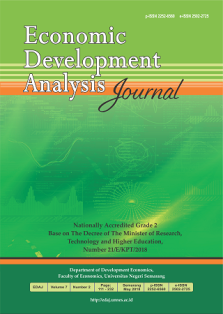The Effect of Macroeconomy Variables on the FDI Inflow in ASEAN 5
Abstract
This study examines and analyzes the factors that influence Foreign Direct Investment (FDI) Inflow in ASEAN 5 (Indonesia, Singapura, Malaysia, Filipina, Dan Thailand). The difference between this study and previous research is in the area and a slight change in the variables. Interest rate, exchange rate, and export are used as independent variables. Meanwhile, the dependent variable is FDI (Foreign Direct Investment). This study was tested using the REM (Random Effect Model) method as the best method than PLS (Pooled Least Square) and FEM (Fixed Effect Model) method after through Chow and Hausman test. The method used in this study refers to the reference literature. The results show that interest rate, exchange rate, and export significantly affect FDI inflow in ASEAN 5. This study provides suggestions for policymakers to control price level/ inflation to maintain society's purchasing power and have trade cooperation with several countries to improve national productivity and export.


